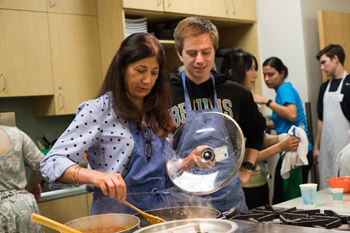Doctors are always advising us to eat healthy but what does that mean? Do they even know?
UCI’s School of Medicine wants to make sure its graduates not only know what it means, but also how to actually prepare healthy meals. For a second year, the medical school is offering a regular course in culinary medicine — basically, cooking classes with a hefty dose of nutrition education.
The classes are taught by Dr. David Kilgore, a professor and family medicine practitioner who specializes in integrative medicine, and by Kim Storm, a registered dietitian with the UCI Health Susan Samueli Integrative Health Institute, and Jessica VanRoo, chef and culinary education director for UCI’s Anteater Recreation Center, where the cooking lessons are held.
On a recent class menu:
Foods to reduce inflammation
 The menu was designed for a lesson on anti-inflammatory diets.
The menu was designed for a lesson on anti-inflammatory diets.
The idea is that doctors who can teach how to eat in ways that produce less systemic inflammation will help patients reduce their risk of cardiovascular disease, certain cancers, autoimmune conditions and possibly Alzheimer’s disease, Kilgore says.
“In our cardiovascular course, we learned that diet can help, but then we didn’t learn anything about what people are supposed to eat or do,” laments first-year medical student Ariana Naaseh, as she chopped garlic in the recreation center’s demonstration kitchen.
“Everyone I tell about this class is so excited.”
In theory, an anti-inflammatory diet is not hard to follow:
- Minimize consumption of sugar, processed foods and red meat — especially charred meat, unless it’s been marinated in something acidic.
- Eat more foods rich in omega 3 fatty acids — think salmon, walnuts and soy beans, among others.
- Eat a rainbow of colorful vegetables.
- Incorporate certain spices, such as cinnamon and turmeric, which are known to reduce inflammation.
Habits are hard to break
 In reality, it’s not so easy. Processed foods are convenient, not to mention designed to satisfy our taste for sweet and salty foods. At the end of a long work day, who has time and energy to prepare a meal from scratch? And how do we make food taste wonderful without adding a lot of salt, sugar and butter?
In reality, it’s not so easy. Processed foods are convenient, not to mention designed to satisfy our taste for sweet and salty foods. At the end of a long work day, who has time and energy to prepare a meal from scratch? And how do we make food taste wonderful without adding a lot of salt, sugar and butter?
“The goal is to eat healthily using whole foods as much as possible, rather than by adding supplements,” Kilgore explains, “and to do it without taking hours to prepare an attractive, wholesome meal.”
Medical school may be the perfect place to teach those skills, UCI and several other medical schools across the country have decided. For one thing, extra time is something medical students find in short supply. And if they can learn the basics of nutritious eating that fits into their busy lives, they’ll be better prepared to help future patients do the same.
Prevention beats treatment
Diagnosis and treatment will always be mainstays of the medical world, but Kilgore says health providers increasingly recognize that it’s better to prevent Type 2 diabetes than to treat a patient for the disease, and that people are healthier if they can avoid high blood pressure and problematic cholesterol counts rather than take pharmaceuticals to control those conditions.
Many doctors do advise their patients to shed weight by exercising and eating better, and for those with high blood pressure, to reduce their sodium intake. But this advice often doesn’t reach patients in ways they can use it. Doctors, themselves, may lack practical knowledge about these topics, let alone have the tools to give effective guidance.
Teaching skills and changing habits
 Graduates of the UCI medical school cooking classes won’t have that excuse. And many of Kilgore’s students are finding their own dietary habits changing as a result of the course.
Graduates of the UCI medical school cooking classes won’t have that excuse. And many of Kilgore’s students are finding their own dietary habits changing as a result of the course.
“It forces me to think a little more about how I’m eating,” says first-year student Daniel Haik. He and fellow student cooks were happy to learn that the breakfast spinach tacos, in particular, could easily be made in large quantities and frozen, then popped into a microwave for a quick, healthy meal any time.
In class, students spend about an hour working in small groups, each one preparing a few simple dishes. Also included are discussions of aspects of healthy eating, instruction on good kitchen skills and case studies to brainstorm ways to improve the health of hypothetical patients through better eating. And of course, they eat.
The future of medicine
“Doctors who do this for themselves are more likely to be able to effectively counsel and guide their patients on how best to overcome common obstacles to healthy eating,” Kilgore says.
It’s a vital step forward in medical practice.
“This is the future of medicine, with more doctors understanding that more medical care doesn’t necessarily equal better medical care,” says Kilgore, who is teaching his students that healthy eating and moderate activity are effective forms of medicine — and ones that don’t carry side effects.
Related Stories



